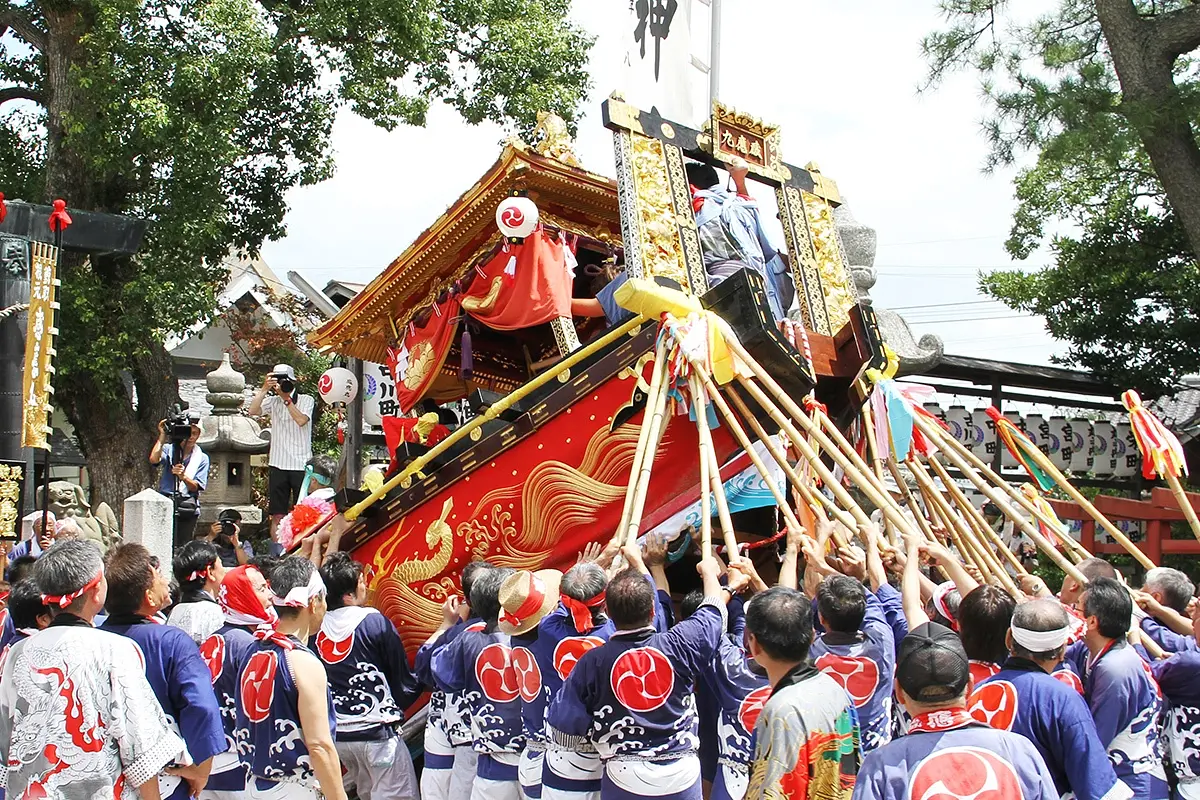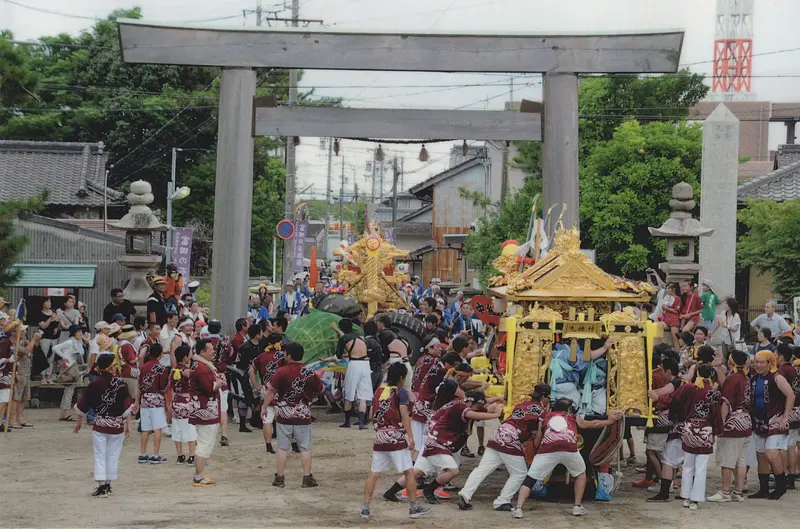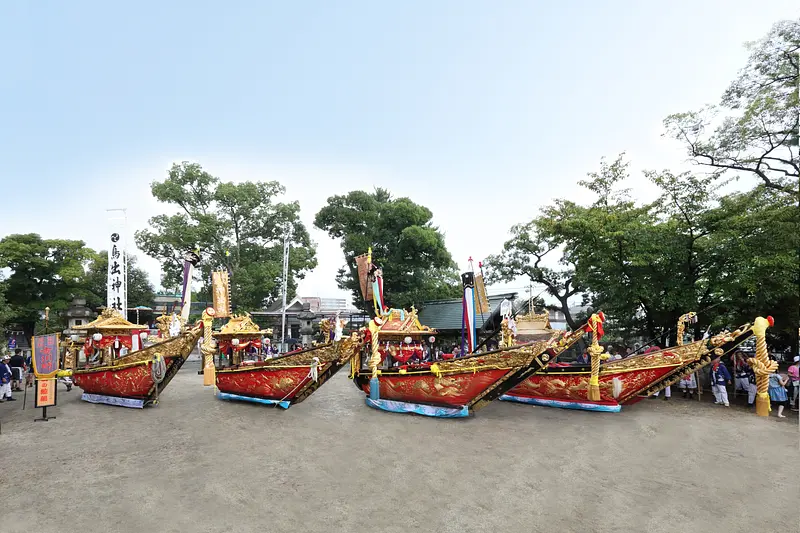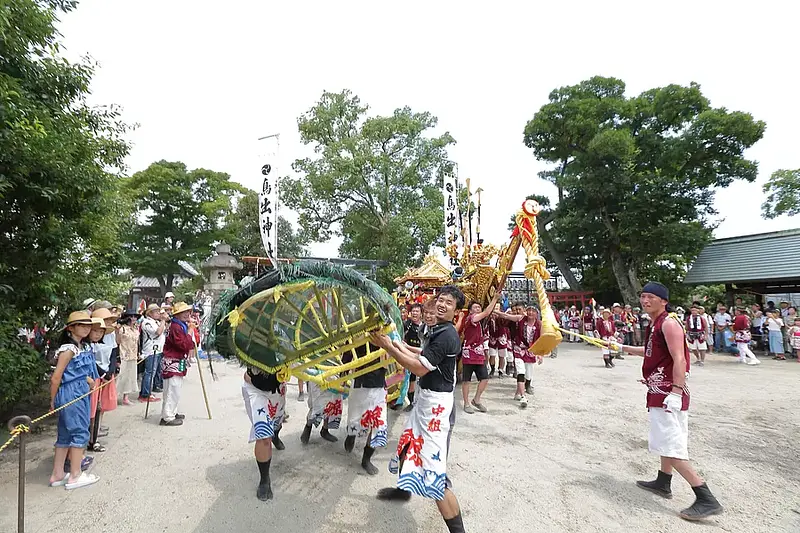

The world-renowned UNESCO Intangible Cultural Heritage "Toride Shrine Whale Boat Event" will be held again this year!
掲載日:2024.08.01
Whale boat events are found in the Hokusei region, and are mock whaling events on land where whale boat floats decorated with gorgeous carvings and curtains chase a papier-mâché whale, are counterattacked, then corner it again and kill it, repeating a series of actions. Among them, the "Toride Shrine Whale Boat Event" is said to have begun at the end of the Edo period, and was designated an Important Intangible Folk Cultural Property of Japan in 1997, and in 2016 was registered as a UNESCO Intangible Cultural Heritage as one of the 33 "Yama, Hoko, and Yatai Events" nationwide.
In recent years, the event has been canceled due to the COVID-19 pandemic, and last year, although they were scheduled to perform at the Daiyokkaichi Festival along with other whaling boat events in other areas, they were unable to do so due to poor weather. Last year, they also performed a town parade at Toride Shrine on the 14th, but a typhoon approached on the 15th, which was the day of the main parade, and the parade was canceled.
This year, why not experience the spectacular whaling performances at Toride Shrine's whaling boat event up close?
The town parade will be held on the 14th, and the main parade will be held at Toride Shrine on the 15th.

It takes place every year on the 14th and 15th of August, with a town parade on the 14th and a parade to Toride Shrine (main parade) on the 15th. The event sees each of the four groups of parishioners (Kitajima-gumi, Nakajima-gumi, Minamijima-gumi, and Furukawa-cho) bring out a whale boat float (Jinja-maru, Shintoku-maru, Kan'no-maru, and Gongen-maru) decorated with gorgeous carvings and curtains, which they use to chase a dummy whale, fight back, and then corner it again and kill it.
The floats are equipped with mantles and are lavishly decorated with gorgeous carvings, side curtains embroidered with gold thread on scarlet silk, and water-pressing poles also made of gold thread. The glittering floats are paraded around in a valiant manner, with dressed-up oarsmen and rowers at the bow and drummers in the mantles, and the event progresses to the accompaniment of songs and drums.
I really want to see the whale boat float.

Although the four groups of floats may look the same at first glance, they all differ in size and have their own unique features. Only the Shintokumaru from the Nakajima group has a strong reddish-red roof, while the other three groups have a gold roof. The Shintokumaru from the Nakajima group and the Kankeimaru from the Nanjima group have dragons embroidered in gold thread on the side curtains attached to the boats, while the Jinjamaru from the Kitajima group has a shachihoko (shachi) and a plover (plovers), and the Gongenmaru from Furukawa-cho has a plover and waves embroidered on them. Spotting the differences is one of the fun parts. If you watch from morning to afternoon during the main parade on the 15th, you may be able to spot the differences.
In the column below, we will introduce each float from each group.
column
Introducing the four sets of floats
You can slide the photos sideways. The photos are presented in the order of the main kneading on the 15th.
The first photo is Jinja-maru from Kitajima-gumi, the second is Shintoku-maru from Nakajima-gumi, the third is Kan'no-maru from Nanjima-gumi, and the last is Gongen-maru from Furukawa-cho. Please take a look at the differences between each one. For a detailed explanation, please see the report article.
Each performance has its own role

Whale boat performances involve "riders" who ride on the boat and "artists" who support the performance without being on board, and as the event approaches they practice their performance, including singing and drumming.
The riders have roles such as "hazashi" (a person who pierces the whale with a harpoon) and "taiko drummer". The main role of the rider is the "hazashi" who shoots the harpoon into the whale, and is played by children around 4th to 6th grade of elementary school. The costume of the "hazashi" will be explained in the column below.
The performers have roles such as the "whale-wearing" performer and the "helmsman." The main performer is the "whale-wearing" performer who carries a papier-mâché whale and moves vigorously. The performers range in age from high school students to around 30 years old. A person who has experience whaling in Norway praised the performance, saying, "The whale's movements are so realistic." It seems that the results of the practice are showing.
column
Check out the authentic Hazashi costume!
The Hazashi differs slightly depending on the group, but they usually wear a light-colored undergarment over which they wear a scarlet jacket with a black collar and multiple gold tassels from the chest to the cuffs. Furthermore, when passing through the torii gate during the Honneri, they always wear a costume called Donza as their "formal attire."
The photos show the donza of each group in the order of Kitajima group, Nakajima group, Minamijima group, and Furukawacho.
Final training schedule

This is the time schedule for the main dance to be held at Toride Shrine on the 15th.
10:00-11:30 Kitajima group
11:30-13:00 Minamijima group
13:00-14:30 Furukawacho
This year, Nakajima-gumi is taking a break, so the main practice will be carried out by three groups: Kitajima-gumi, Minamijima-gumi, and Furukawa-cho.
There are lots of delicious restaurants near Toride Shrine! The popular "Tuna Restaurant"

There are no food stalls at the Toride Shrine Whale Boat Event, but there are plenty of delicious restaurants near the shrine. There is also a tuna restaurant that has been talked about on TV and social media within walking distance. There is also a himono restaurant and a local sushi restaurant, so if you get tired of sightseeing, why not stop by for a delicious meal?
Tuna restaurant
Address: 1-15 fuso 2-chome YokkaichiCity Mie Prefecture
Phone number: 059-365-6064
For more details, see this report article.
Speaking of summer festivals, shaved ice is a must-try. You can enjoy it at Sebon Marusan!

If you want to eat shaved ice at the summer festival, there is a delicious shop within walking distance of Toride Shrine: Sebon Marusan.
The shaved ice is made by a Western confectionery shop, so you can enjoy a luxurious sweet shaved ice using anglaise sauce, a type of custard sauce, espuma, compote, and gelato.
Address: 8-11 Toshimaharacho YokkaichiCity Mie Prefecture
Access: 535m from JR "Tomita Station"
Sebon Maruzo's Instagram can be found here
column
Introducing Sebon Marusan's shaved ice!
The most popular item this time of year is shaved ice made with fresh peaches. The combination of espuma and peach is amazing! It's more of a peach dessert than a shaved ice. The "Hydrangea Special" is colored with butterfly pea, and the jelly is also colorful, so it's sure to look great on social media!
They even have grilled corn shaved ice! The corn is roasted to bring out its aroma, then milk and sugar are added and blended into a paste. It's topped with grilled corn! On this day, we also had grilled eggplant ice cream as an option. Apparently, this was inspired by a French restaurant. We added mitarashi dango sauce to change up the flavor. It's a delicious surprise. Starting from the first photo, we have the strawberry pie, peach, grilled corn, and hydrangea special flavors.
For details on the "Toride Shrine Whale Boat Event" please see the report article
The report article introduces the differences between the floats and the highlights of the festival, as well as explaining the schedule and access on the day.
We also publish information about nearby restaurants where you can eat delicious food.
Check out the link below for more details 👇








